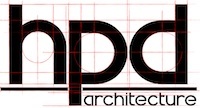 HPD Architecture gets it.
HPD Architecture gets it.
Plain and simple.
This three-person Dallas-based architecture and interior design firm has made progress in the social media world that you just don’t see every day; especially compared to other professional services firms.
By blogging, podcasting, and interacting with the design community online, these guys have raised their visibility to a national level. And in a world of referrals and word-of-mouth marketing, they are driving serious traffic to their website and generating targeted, qualified leads online.
How can three busy people accomplish this? I had the opportunity to chat with HPD vice presidents Laura Davis (@hpdArchitecture) and Larry Paschall (@ArchHappyHour) to find out.
Embrace it, Commit to it, and Don’t Look Back
HPD started their quest for online success in 2009. Like many firms new to the digital space, the team was unsure of how to get going and what to expect. With the economy tanking and eager to find a new marketing channel, they turned to social media to increase market exposure and lessen their dependencies on referrals.
“Our original goal was brand awareness,” said Laura. “We opened our doors in 2008, and nobody knew who we were. It was important to increase visibility in order to survive in the rough economy.”
At the time, the firm had no website. So while Davis was creating a website, she set up Facebook and Twitter pages and began exploring their possibilities. Before long, HPD became conviced that social media was a legitimate long-term marketing channel that would increase awareness of the firm in their local community and industry.
Find Your Position Before You Start Running
Before HPD began spreading the word online, they realized it was necessary to have a concrete brand strategy. In working sessions the team hashed out a range of critical issues, such as:
- Who is HPD?
- What do we stand for?
- Who are our target clients and how do we reach them?
- What is our position in the marketplace and what are our messages?
These fundamental working sessions proved to be crucial. The firm’s positioning as an architecture and design resource allowed the firm to gain traction in noise-flooded places such as Twitter. In fact, it is largely why they are so well known online today.
Why Use One Weapon When You Have Many?
Once HPD’s brand strategy was in place, they took advantage of several online marketing platforms:
- Twitter – Davis and her team began following people relevant to their community. They invested a significant amount of time meeting design community members and finding ways to add value to discussions. Initially they interacted with local folks, but over time their reach expanded geographically. The network grew as Davis shared links to interesting content on other design websites, gradually building trust and credibility.
- Facebook – The firm uses their Facebook page as a place to post interesting articles. Again, the goal was to build a reputation as a resource for the architecture and design community. By talking about the industry and not directly promoting HPD itself, they’ve created a high quality educational resource where people could find and retrieve information.
- Podcasts – After seeing other companies have success with webinars, HPD decided to try their hand at a similar media form: audio podcasts. Their branded series, called The Architecture Happy Hour, is a monthly audio recording of Laura and Larry talking about anything from tips for home owners to gays in architecture. The team uses social media to promote the podcast, and over time they have built a following of loyal subscribers.
- Blog – Some companies use their blog to talk about their firms’ latest and greatest accomplishments. By contrast, HPD uses its blog to spotlight innovative and interesting happenings within its community. It also used this space to summarize podcasts and re-publish interesting discussions. The blog is another place for the team to share expertise, interact, and develop trust.
Kindergarten Basics – Sharing is Good
In a world filled with spam, promotions, and other noise, the last thing community members want to see in their Twitter feed is an advertisement or press release. HPD understands this, and from day one they have built relationships — and their reputation — on the quality of content that they share.
Their thinking goes like this: people who share carefully selected industry news, photos and articles will be respected and followed. Before HPD had any content of their own to contribute, they were promoting other websites and influencers. And once they had a podcast to share, followers were all ears.
A One-Hour Workout Per Day
The HPD team dedicates on average an hour per day on social media efforts. This includes:
- Recording and editing podcasts
- Interacting, responding, and sharing on Twitter
- Sharing content on Facebook
- Writing blog posts
One tool HPD has found useful is Hootsuite. This software allows a person to manage multiple accounts and platforms from one place. If Laura wants to share an article on two Twitter accounts, a Facebook page, and a LinkedIn profile, she can do it quickly and efficiently with Hootsuite.
Yes, You Still Have to Get Off Your Butt
An important note to add to this discussion is that all three HPD team members still go out and network at live events, including their own monthly happy hour. They have not given up on in-person networking, but they have supplemented traditional marketing tactics with social media.
Meeting someone digitally is no replacement for shaking a live hand, especially in a field such as architecture where people are the product. Preliminary findings from Hinge’s ongoing online marketing research study tells us that the fastest growing companies are employing both traditional and digital forms of marketing. Before you allocate all of next year’s marketing budget to social media, remember that a good old fashioned cocktail can still be an effective way to start a business relationship.
Is It Worth It?
Most marketing companies out there will tell you social media is necessary. But what does a firm that’s actually doing it and has been for two and a half years have to say?
Larry Paschall: “When Laura walked in one afternoon and told us that we were on Facebook and Twitter, Holly and I were pretty skeptical that it was going to generate work for our firm. However, in the last two and half years, our online presence has led to our being interviewed for various publications, speaking at industry conferences, and being seen as a go-to resource both inside and outside of the design community. More importantly, new clients are finding us online.”
Google has noticed the online activity. HPD’s website and blog are being indexed and qualified leads are coming to the site from valuable search terms, such as “home design in Dallas.” These qualified leads are a direct indicator that their online efforts are paying off.
HPD started with a goal to increase visibility in the marketplace. That I’m sitting half way across the country writing about their success indicates that their strategy is working.
Here’s how you can get in touch with HPD:


